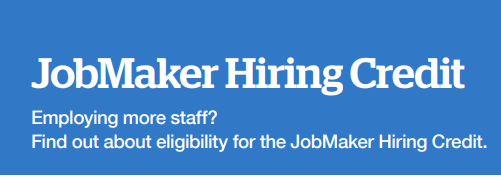The Australian Government announced the JobMaker Hiring Credit as part of the Australian Federal Budget. The hiring credit is an incentive for employers to create new jobs for young jobseekers between the ages of 16 and 35 years.
Under the proposed measures, for each eligible position CREATED between 7 October 2020 and 6 October 2021, eligible employers will receive $200 per week for each additional employee aged 16 to 29, and $100 a week for each additional employee aged 30 to 35 years old. The credits will be able to be claimed for a 12 month period from the date each new position was created.
Employer Eligibility
To be eligible, employers must have;
- An ABN
- Registered for PAYG withholding
- Up to date with relevant income tax and GST
- Reporting payroll through Single Touch Payroll
- Are NOT claiming JobKeeper payments
Employee Eligibility
To be eligible, employees must have;
- Commenced employment with the employer between 7 October 2020 and 6 October 2021
- Aged between 16 to 35 at the time they were hired
- Must complete the JobMaker Employee Notice
- Meet the "pre-employment" condition of receiving either; JobSeeker, Youth Allowance or Parenting payments for at least four weeks of the 12 weeks prior to the hire
- Have worked at least an average of 20 paid hours per week
- Not an employee of another employer claiming the credit
- Must not be a partner, beneficiary or shareholder or director or a relative of one, of the employer
job creation eligibility
Once the eligiblity above have been met, there are certain payroll criteria to consider;
- Headcount Numbers - Total employee headcount must increase from 30 September and the Jobmaker period of 3 months. Each quarter empoloyers will need to test that employee headcounts have creased compared to the reference period.
- Payroll dollar increase - Total payroll wage costs must increase from the 3 months up to 6 October 2020 compared to the reference period
Example 1 - Employer replaces one job with two part-time jobs with the same salary
John runs a tiling company with one full-time employee. His employee is paid a salary of $70,000, and so for the 3 month period to 6 October, the total baseline payroll amount is $17,500.
John's full-time employee quits in early October, and he hires two part-time employees instead to replace the full-timer. He pays each of the two part-timers, $35,000 per year.
John's total payroll expense for the first JobMaker period will still be $17,500 ($70,000 per annum equivalent), so while his headcount increased, he has NOT had a payroll increase.
John is NOT eligible to a JobMaker Hiring Credit for this period
How the JobMaker Hiring Credit scheme works
- Register for the JobMaker Hiring Credit. This is done through the ATO business portal or via Eye on Books agent portal. To register you will need to provide the ATO with your employee headcount and also your baseline payroll figures. You will be able to amend the figures above until you submit your first JobMaker Hiring Credit claim
- Nominate your eligible employee hires through STP enabled software. NOTE: Xero/MYOB have not yet updated their software to allow this
- Claim every 3 months from 1 February 2021 through the ATO portal or via your BAS Agent (Eye on Books). You will need to meet the eligiblity requirements before you can claim
Payroll complexity
Your baseline payroll amount will change each quarter depending ont he number of days in the JobMaker period that you are claiming for. At registration you will provide the payroll for the three-month period ending on 6 October 2020 (being a 92 day period).
When claiming for JobMaker periods that have a different length, the ATO will ask you to re-enter your baseline payroll. You will need to disregard any payroll expenses that you included at registration if they were paid on days outside the baseline payroll period.
Number of days in each JobMaker period
|
JobMaker period |
JobMaker period dates |
Days in JobMaker period |
|---|---|---|
|
1 |
7 October 2020 – 6 January 2021 |
92 |
|
2 |
7 January 2021 – 6 April 2021 |
90 |
|
3 |
7 April 2021 – 6 July 2021 |
91 |
|
4 |
7 July 2021 – 6 October 2021 |
92 |
|
5 |
7 October 2021 – 6 January 2022 |
92 |
|
6 |
7 January 2022 – 6 April 2022 |
90 |
|
7 |
7 April 2022 – 6 July 2022 |
91 |
|
8 |
7 July 2022 – 6 October 2022 |
92 |
The Takeaway
For any employers currently hiring or intending to hire new additional young jobseekers and is likely to meet the criteria, it's important to consider the procedures and processes that will need to be in place to monitor, record, track report AND claim credit entilitements, in addition to meeting the quarterly administration requirements.
Furthermore, as employers are unable to claim retrospectively for previous JobMaker periods, employers should ensure that potential eligible employees have completed the approved nomination forms and submit the employer participation form as soon as possible with the first JobMaker period end date of 6 January 2020 fast approaching.
At Eye on Books we manage the full JobMaker process for our clients, ensuring they meet the necessary deadlines and don't miss out on any potential JobMaker hiring credit support to help them in their ecenomic recovery. If you are unsure if you're eligible for JobMaker for your business, contact us and we'll help you through the process.




















